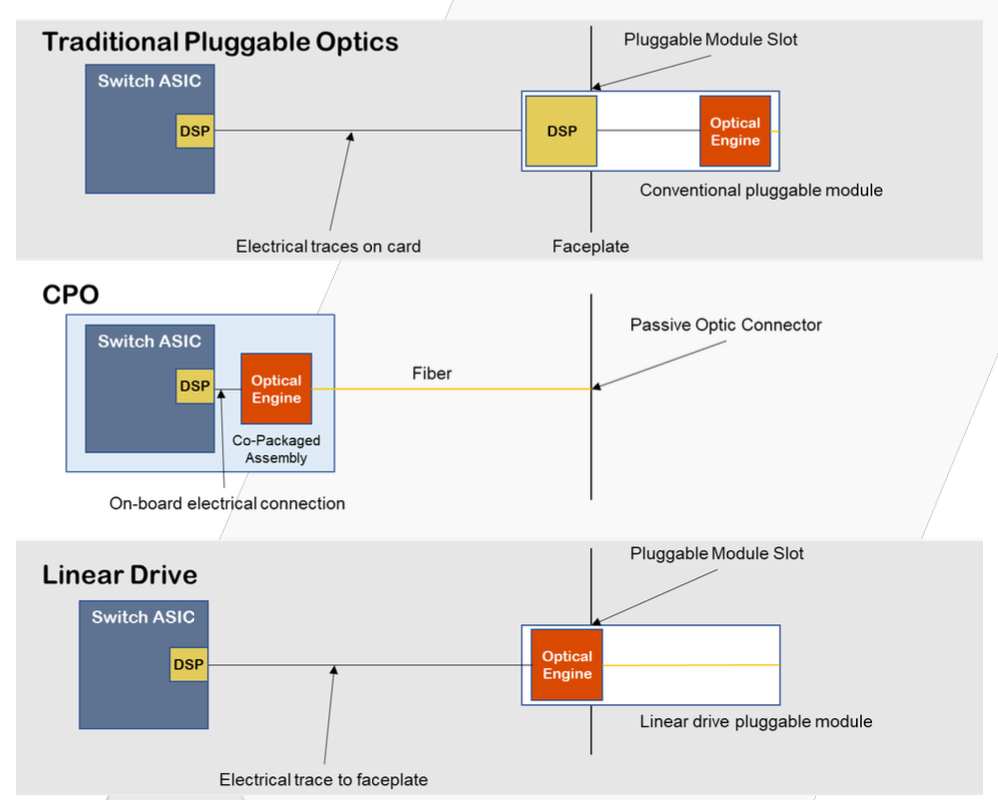A key theme at OFC earlier this year that surprised many was linear drive optics. Its attention at the optical communications and networking event was intriguing because linear drive - based on using remote silicon to drive photonics - is not new.
 Scott Wilkinson
Scott Wilkinson
"I spoke to one company that had a [linear drive] demo on the show floor," says Scott Wilkinson, lead analyst for networking components at Cignal AI. "They had been working on the technology for four years and were taken aback; they weren't expecting people to come by and ask about it. "
The cause of the buzz? Andy Bechtolsheim, famed investor, co-founder and chief development officer of network switching firm Arista Networks and, before that, a co-founder of Sun Microsystems.
"Andy came out and said this is a big deal, and that got many people talking about it," says Wilkinson, author of a recent linear drive market research report.
Linear Drive
A data centre's switch chip links to the platform's pluggable optics via an electrical link. The switch chip's serialiser-deserialiser (serdes) circuitry drives the signal across the printed circuit board to the pluggable optical module. A digital signal processor (DSP) chip inside the pluggable module cleans and regenerates the received signal before sending it on optically.
 Source: Cignal AI
Source: Cignal AI
With linear drive optics, the switch ASIC's serdes directly drives the module optics, removing the need for the module's DSP chip. This cuts the module's power consumption by half.
The diagram above contrasts linear drive optics compared with traditional pluggables and the emerging technology of co-packaged optics where the optics are adjacent to the switch chip and are packaged together. Linear drive optics can be viewed as a long-distance variant of co-packaged optics that comntinues to advance pluggable modules.
Proponents of linear drive claim that the power savings are a huge deal. "There will probably also be some cost savings, but it is not entirely clear how big they will be," says Wilkinson. "But the only thing people want to discuss is the power savings."
Misgivings
If linear drive's main benefit is reducing power consumption, the technology's sceptics counter with several technical and business issues.
One shortfall is that a module's electrical and optical lanes must match in number and hence data rate. If there is a mismatch, the signal speeds must be translated between the electrical and optical lane rates, known as gearboxing. This task requires a DSP. Linear drive optics is thus confined to 800-gigabit optical modules: 800GBASE-DR8 and 800-gigabit 2xFR4. "There are people who think that at least 800 Gig - eight lanes in and eight lanes out - will continue to exist for a long time," says Wilkinson.
Another question mark concerns the use of optics for artificial intelligence workloads. Adopters of AI will be early users of 200 gigabit-per-lane optics, requiring a gearbox-performing DSP.
Moreover, the advent of 200-gigabit electrical lanes will challenge serdes developers and, hence, linear drive designs. "It will be a technical challenge, the distances will be shorter, and some think it may never work," says Wilkinson. "No matter how good the serdes is, it will not be easy."
Co-packaged optics will also hit its stride once 200-gigabit serdes-based switch chips become available.
Another argument is that there are many ways to save power in the data centre; if linear drive introduces complications, why make it a priority?
Linear drive optics requires the switch chip vendors to develop high-quality serdes. Wilkinson says the leading switch vendors remain agnostic to linear drive, which is not a ringing endorsement. And while hyperscalers are investing time and resources into linear-drive technology, none have endorsed the technology such that they can withdraw at any stage without penalty.
"There is one story for linear drive and many stories against it," admits Wilkinson. "When you compile them, it's a pretty big story."
Market opportunity
Cignal AI believes linear-drive optics will prove a niche market, with 800-gigabit linear-drive modules capturing 10 per cent of overall 800-gigabit pluggable shipments in 2027.
Wilkinson says the most promising example of the technology is active optical cables, where the modules and cables are a closed design. And while many companies are invested in the technology, and it will be successful, the opportunity will not be as significant as the proponents hope.